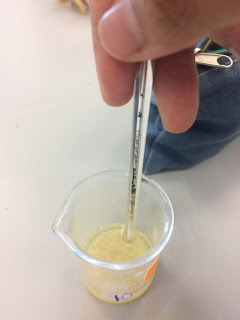LAB 5: LIPID ANALYSIS
1.0 INTRODUCTION
Lipids
are classified as organic compounds that are soluble (dissolvable) in organic solvents, but only sparingly soluble
in water. Lipids are biologically important for making barriers (membranes of animal cells), which control the
flow of water and other materials into a
cell. There are several classes of lipids, including fatty acids, waxes, triacyglycerols (fats and oils),
phospholipids and steroids. The fatty acids are usually not free in nature, but are components of
triacyglycerols, waxes, and phospholipids
Lipids are major components of cell membranes, and are responsible for most of the permeability filter
functions of membranes. Membranes act as barriers
to separate compartments within eukaryotic cells, and to separate all cells from their surroundings.
1.1 OBJECTIVE
- To
determine the percentage of lipid extraction of the food samples.
- To extract lipids from food samples.
1.2 MATERIALS
1. Food samples
(potato chips etc)
2. Petroleum
ether
3. Ethanol
4. Deionised
water
5. Test tubes
(small and large) and stand
6. Pipette
7. Measuring
cylinder
8. Dropper and
spatula
9. Erlenmeyer
flask.
10. Beaker
11. Weighing
scale
12. Hot plate
1.3 METHODOLOGY
Extraction of lipids from foods.
1. About 2 grams of food samples (potato chips etc) were weighed.
2. The food sample were crushed into
small pieces using mortar and pestle.
3. An empty beaker are weighed with a
glass rod inside. The weight are recorded
in Table 2.
4. The crushed food were placed in the
above beaker.
5.
The
beaker (with a glass rod) containing the crushed food were weighed. The weight were recorded in Table 2.
6. 10
ml of petroleum ether were added to the
flask containing crushed food and stirred with the glass rod for 10 minutes to get the lipids to
dissolve in the petroleum ether (in a well ventilated area or use a hood).
7. Carefully decant the petroleum ether
from the beaker (pour only the clear liquid, not the solid portion of the food
8. The beaker containing the remaining
solid food were placed on a hot plate to evaporate all of the petroleum ether
(in a well ventilated area).
9. Check to see that there is no longer a strong smell characteristics
of the petroleum ether, and the beaker was allowed to cooled
10. After the beaker has cooled to room
temperature, the beaker and remaining food were weighed again (with the glass rod). The weight was recorded in Table 2.
1.4 RESULT
Table 2. Extraction of lipid.
Foods
|
Weight
of
|
Weight
of
|
Weight
of
|
Weight
of
|
Weight
lost
|
%
Lipid
|
empty
|
beaker
with
|
crushed
|
beaker
|
from
food
|
extraction
|
|
beaker
(with
|
crushed
raw
|
raw
food
|
with
dried
|
(weight
of lipid
|
||
glass
rod)
|
food
(with
|
food
(with
|
extracted)
|
|||
glass
rod)
|
glass
rod)
|
|||||
Bun
|
49.09g
|
51.09g
|
51.09 – 49.09
= 2.00g
|
50.59g
|
51.09 – 50.59
= 0.5g
|
0.5/2.00 X 100
= 25 %
|
Cracker
|
47.20g
|
49.20g
|
49.20 – 47.20 = 2.00 g
|
48.69 g
|
49.20 – 48.69
= 0.51g
|
0.51/2.00 X
100
= 25.5 %
|
Potato
|
45.50
|
47.50
|
47.50 - 45.50 =2.00
|
46.93
|
47.5 - 46.93 =
0.57
|
0.57/2.00 X 100
= 28.5 %
|
chips
|
||||||
Rempeyet
|
51.21g
|
53.21g
|
53.21 - 51.21
= 2.00g
|
52.68g
|
53.21 - 52.68
= 0.53g
|
0.53/2.00 X 100
= 26.5 %
|
Sunflower seeds
|
53.17g
|
55.17g
|
55.17–53.17
= 2.00g
|
54.59g
|
55.17 – 54.59
= 0.58g
|
0.58/2.00 X 100
= 29 %
|
(% lipid extraction = weight of
lipid extracted/weight of crushed food sample x 100%
1.5
DICSUSSION
Based from the result that we obtain
from this lipid analysis experiment, we can see clearly which sample has higher
lipid content. In this experiment, we choose 5 different samples. To get the
reading of the lipid content, we compare the weight of the beaker with raw before
and after heating the raw food with petroleum ether. After decant all the petroleum
ether, we dried the food to evaporate the petroleum ether. Then we weighed the
beaker containing raw food. We found that that the mass of the raw food
decreases and this means that the food contain lipid.
The function of the petroleum ether was actually to extract all the lipid
contains in the raw food, leaving non lipid behind.
To compare, sunflower seeds has the higher percent of lipid content,
compare to the other 4 samples, which is 29%. The samples that has less lipid content is
bun, which is only 25%.
1.6
CONCLUSION
To conclude, lipid can be identified
and extracted from various of food and different food contain a different
percent of lipid.
1.7 REFERENCES
- Lab report 4 lipid. (n.d.). Retrieved from
https://www.scribd.com/document/367097238/lab-report-4-lipid
Flow Cart







Comments
Post a Comment